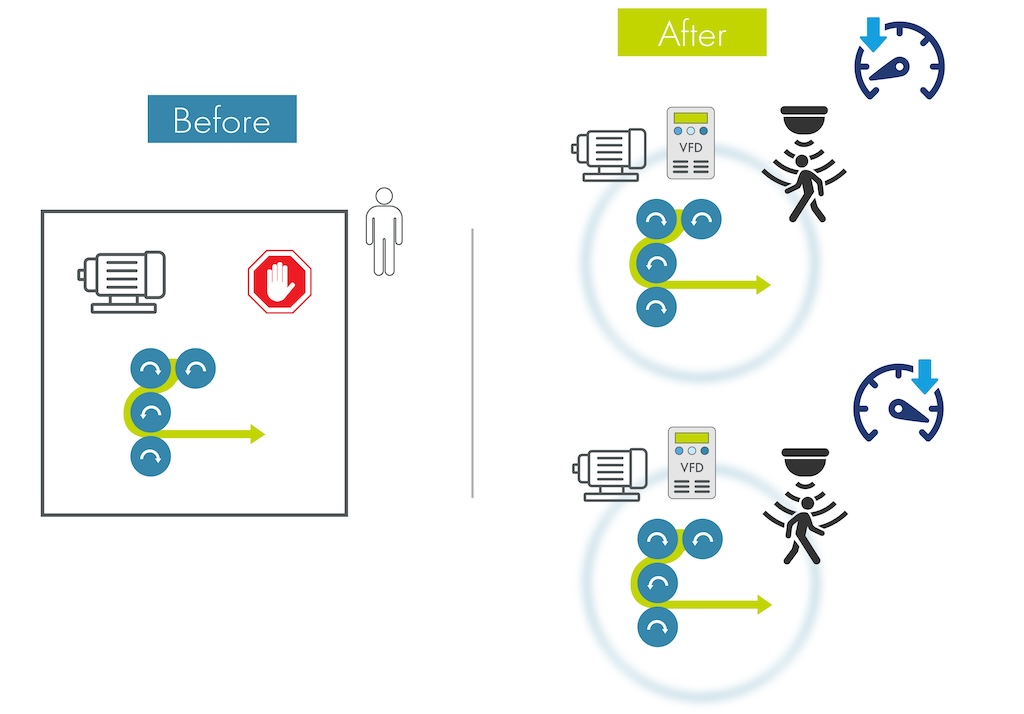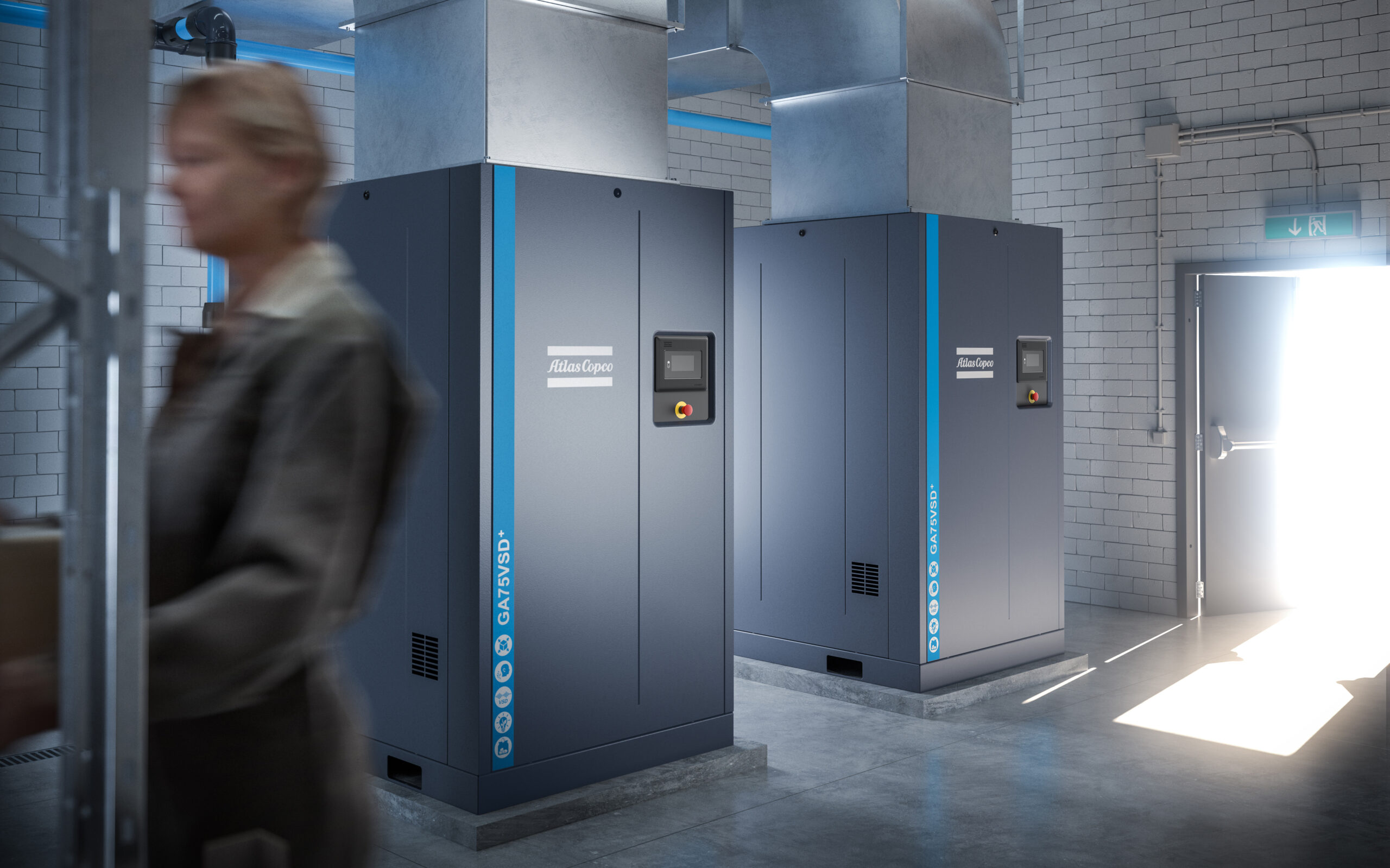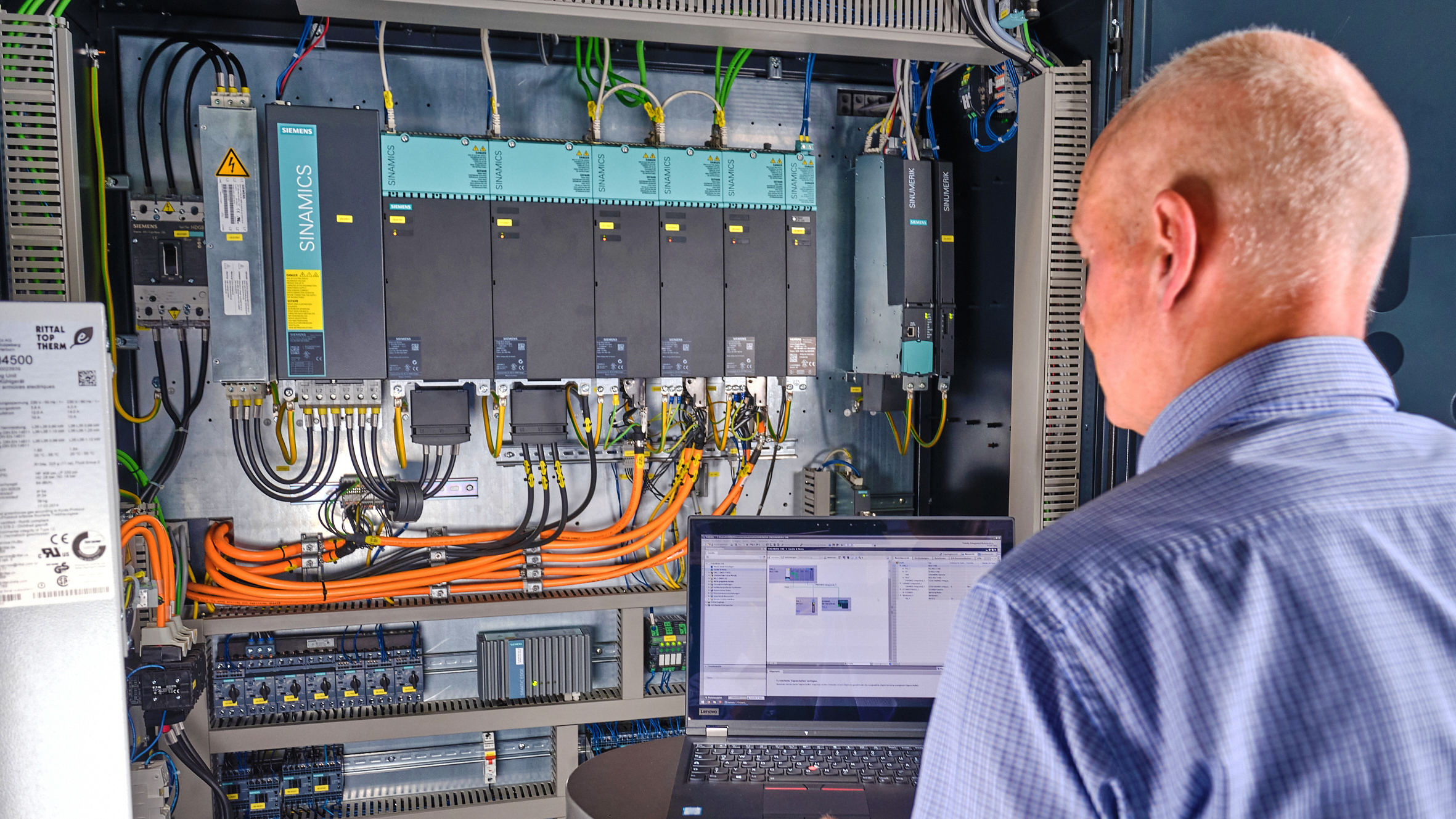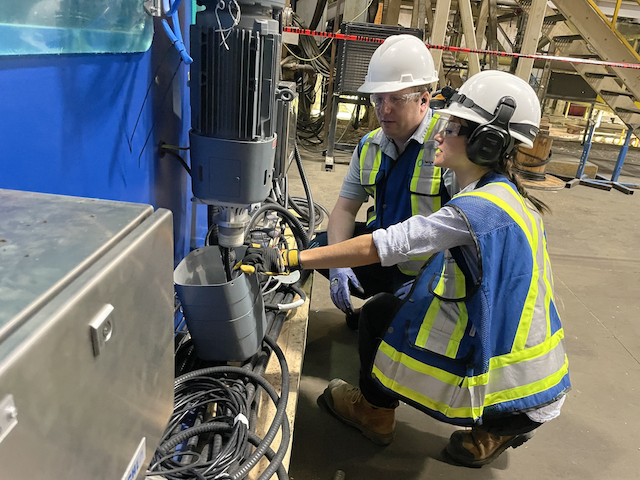The types of ac drives used with ac induction motors are V/Hz, encoderless and flux vector. While there are many drives available for synchronous and servo motors, induction motors have the majority of applications. Sensorless vector control is the same as encoderless vector control, which better describes its operation.
The types of ac drives used with ac induction motors are V/Hz, encoderless and flux vector. While there are many drives available for synchronous and servo motors, induction motors have the majority of applications. Sensorless vector control is the same as encoderless vector control, which better describes its operation. Encoderless vector ac drives operate in an open-loop mode because they do not use tachometers or encoders. Flux vector ac drives provide tighter speed regulation than encoderless vector drives. The use of a tachometer or encoder allows the flux vector drive to provide a higher degree of control over motor speed and performance.
Danaher’s FX4000 Fusion line of flux vector drives includes fifth-generation IGBT intelligent power modules, which offer low losses and enhanced self-protection for short circuit, under-voltage, and over-temperature; and a single axis motion controller, which allows control of both speed and shaft position.
“The single, most important driver for ac drive purchases is the continued rise in energy costs, primarily due to the upward movement of the price of oil,” said Mark Kenyon, product marketing manager, low-voltage drives at ABB. “This increase has a direct and immediate impact on energy costs, forcing manufacturers to focus on energy conservation measures. Low-power ac drives provide a distinct energy saving advantage when deployed for the control of motors used in manufacturing industries consuming significant power.”
Harmonics factors
“As ac drive usage increases, the amount of harmonic current will also increase, further straining the already stressed distribution grid. This will eventually force manufacturers to place more emphasis on purchasing ac drives that provide some means of harmonic mitigation,” Kenyon added.
Harmonic voltage and current are caused by nonlinear loads connected to the power distribution system. Power electronic converters used in different types of electronic systems — including ac drives — can increase harmonic disturbances by injecting harmonic current directly into the electrical system. Harmonics can overheat transformers, cables, motors, generators and capacitors connected to the same power supply as the devices generating the harmonics.
To mitigate harmonics generated by ac drives, ABB supplies an integral 5% impedance dc-bus choke or 3% impedance ac-line reactor as standard for products ranging in size from 1 hp to 3,000 hp. ABB’s ACS800 family of ultra-low harmonic drives are reported to exceed the IEEE 519-1992 standard. These drives use an active converter to eliminate low-order harmonics, and an active front-end LCL line filter to reduce harmonics above 1 kHz.
Baldor also uses both passive and active harmonics mitigation techniques. “With a standard 6-pulse input drive, harmonics can be as high as 80% at full load,” said Jeff Lovelace, drives marketing specialist at Baldor Motors, Drives and Generators. “With a simple 3% reactor, this number moves down to the 40% area. We offer two methods of harmonic mitigation. The first is a passive harmonic filter added to the input of the control. This can reduce harmonics to 10% to 15%. We also have an active filter that can reduce this number.”
Rockwell Automation’s PowerFlex 70 is a flux vector ac drive that offers DeviceNet, ControlNet and EtherNet networking options and features seamless integration into a control system. For example, it can automatically populate drive parameters and tags into the PLC program, or automatically replace the drive configuration if a failed drive is replaced with a new drive.
Schneider Electric’s active harmonic control technology is called AccuSine, which monitors a distorted electrical signal, and then cancels harmonics with the dynamic injection of opposing current. Schneider also offers passive technology as well as a phasing shifting transformer and an 18-pulse diode bridge. Yaskawa Electric America uses 12 and 18-pulse technologies as well as passive devices such as dc-link chokes.
Programming
Torque control, tripless operation, dynamic braking, zero speed control and line regeneration remain popular features that influence ac drive purchases. But today, programming — or ease thereof — and networking are two of the main issues driving the drives market.
Most drive manufacturers offer removable keypads that enable distributors, OEMs and end users to put drives to work quickly. Although removable keypads are not new to ac drives — they began to show up in the early 1990s — their functionality, flexibility and capacity continue to increase.
Keypads facilitate programming and efficiency. They typically include copy functions to move parameters from one drive to another. Some keypads include startup, troubleshooting and maintenance assistants that guide you through drive setup and operation, real time clocks and even error loggers, which can provide a snapshot of operating conditions in the event of a drive fault.
Baldor’s H2 drive has a removable keypad with onboard memory. It can store up to four parameter tables and then download them to other drives. Mitsubishi’s latest keypad can store data for up to four drives.
Rockwell Automation recently launched a wireless interface module and software tool called Pocket DriveExplorer, which enables users to access drives via wireless handheld devices.
Most ac drives include a removable keypad that speeds up parameter selection, setup and programming. ABB recently released FlashDrop allows you to set parameters without a power connection to the drive. A drive can be programmed by inserting the FlashDrop probe into the receptacle on the front of the drive.
FlashDrop technology is an option with ABB’s newly-released ACS150 line of drives. As with most keypads, the hand-held unit speeds up parameter selection and setup. “Setting parameters can be done without a power connection to the drive” said Jukka Nurmi, product line manager, low voltage drives, at ABB. “In fact, it is not even necessary to unpack the drive. The FlashDrop probe simply is inserted into the receptacle on the face of the drive.”
Startup wizards, preprogrammed applications and PC programming software also help simplify programming of complex drive features. Drives from Eaton, Baldor, Mitsubishi, Rockwell Automation, Yaskawa, AutomationDirect and Emerson boast these features.
For example, Emerson and Mitsubishi drives are configured to show the first 10 parameters, which will suffice for many applications. Drives from Danaher, AutomationDirect and Yaskawa are set with factory default parameters to run out-of-the-box for general purpose applications. In many cases, the user must enter only the nameplate information from the motor into the drive if it differs from the default.
Drives can be extremely complex. Many have around 350 parameters available to control an induction motor’s performance. Some drives have from 30 to 50 parameters, while the A700 from Mitsubishi has more than 700. However, keeping parameter numbers the same across model numbers helps simplify programming, as does the A700’s auto-tuning system, which allows the drive to fine tune itself for a specific motor.
“The first 10 parameters cover the fundamentals and are usually enough to get you started,” said Chris Cusick, marketing manager, VFD product group, at Mitsubishi Electric Automation. “We always keep a parameter number in the same place so someone familiar with a Mitsubishi drive made 20 years ago would still find that Parameter 7 means the same now as it did then.”
Mitsubishi also offers software called FR-Configurator that allows users to either set the parameters from a laptop or avoid using parameters. Settings are changed depending on motor information, the length of ramps and load types. Parameters are automatically alerted without needing to know any of the numbers.
Baldor’s software, called Mint Workbench v5.5, walks you through the setup procedure. For those looking for more advanced control setup, Mint Workbench v5.5 offers an oscilloscope feature that helps fine tune the speed and current loops inside the drive.
These ac drives operate the butterfly valves that control the volume and flow of treated cooling water for an air conditioning application in Toronto, Canada. Water at 39 F is taken from the bottom of Lake Ontario and sent to the Toronto Island Water Filtration Plant to be purified. The treated water is then forwarded to a heat transfer station and used to lower the temperature of water used for air conditioning in downtown buildings.
ABB’s FlashDrop unit can be connected to a PC for additional storage capacity. Parameter sets are created or edited using its PC interface.
Yaskawa provides Drive Wizard, a free, PC-based support tool for drive commissioning and maintenance. Drive Wizard allows drive operation, parameter changes and upload, download, monitor and graph parameters.
Schneider Electric includes a “Simply Start” menu on its recently-released Altivar 71. This provides quick access to the last several parameters changed and a “go to” button to speed navigation. AutomationDirect’s GSoft configuration software offered with its DURApulse series features a schematic view and trend display to assist in drive tuning.
Programming simplification is not always necessary. “It depends on the application and type of drive,” said Tim Schumann, corporate engineer at SEW Eurodrive. “If the application is a conveyor belt, they are quite easy. If the machine is a position-controlled system, then it depends on the needed movement and handshaking of signals between the external processes, so those can be quite complex.”
Networking
Most ac drive manufacturers provide units with networking capability. There are numerous ways to provide remote signals to drives, but 0-10 Vdc and 4-20 mA remain the most popular means of providing speed and torque references. However, the popularity of Ethernet is increasing. Other networking options include DeviceNet, RS485, Modbus, BACnet, LonWorks, Profibus, ProfiNet, Interbus and CANopen.
Factors that influence networking drives include reduction of wiring costs, coordinated control, need for diagnostic feedback about the drive’s health and the ability to configure a drive from a PLC. Process automation and machine synchronization are growing applications for drives that must interact.
Baldor recently built a Web server option into its drives. A computer network can be connected into the control to “surf the drive” using a standard Web browser such as Internet Explorer or Netscape. No special interface is needed — just a standard Cat-5 cable. The parameters can be saved and edited and the drive’s status can be checked.
“With the proliferation of networks and networking equipment, the cost of connecting a drive to a network can be less expensive and more reliable than the traditional hardwired signals and provide valuable feedback and functionality,” said Ivan Spronk, ac drive product line manager at Schneider Electric. “An ac drive on an Ethernet network can be viewed, monitored and even reset from anywhere the user chooses.”
“The primary drivers for networking are the connection cost-per-node and the cost of the network card,” said Kenyon. “If you want to control 10 drives with a speed reference, start/stop, forward/reverse and have one analog output signal, you would need to connect at least three wires for the speed reference (common, reference and shield), one wire for start/stop, one wire for forward/reverse, one wire for digital common and two wires for an analog output — a total of eight wires.”
“If the cost of pulling and landing one wire is $100, then it’s $800 per drive or $8,000 for a 10-drive system compared to landing a twisted pair of wires for one drive at $200 for serial communications, or $2,000 for a 10-drive system. The cost of network cards for each drive compared to the cost of each drive is another consideration. Although the price-per-card is coming down dramatically, the cost-per-card for a small horsepower drive can be equal to the price of the drive. As the horsepower rating of each drive becomes larger, the average drive purchase price becomes a much higher percentage, compared to the cost of the network card.
“Networking is the right way to go if you want to connect many drives and want to control them as a batch with status feedback for a process, whereas control of a single drive using a network may not be an economical decision based on the cost of the network card compared to the cost of pulling and landing wire.”
Drive applications
The best opportunities for using ac drives come with machines that operate partially loaded for significant periods. Adjustable speed drives should be considered when:
-
Designing new facilities
-
Modifying existing installations or processes
-
Procuring prepackaged equipment
-
Replacing oversized or under-loaded motors
-
Setting up an energy management or preventive maintenance program.
-
The open loop or constant V/Hz is the most popular drive for small horsepower applications. Generally, a standard V/Hz drive is used when speed regulation of around 1% is acceptable, in applications where the load is variable torque, for applications where motor speeds can reach 10,000 rpm and any application not requiring more than a 10:1 speed range or rapid dynamic response. V/Hz drives offer an affordable solution to less demanding applications such as pump, fan, HVAC and conveyor applications. V/Hz is a must for multiple motors.
Encoderless vector drives enable 100% torque down to around 1 Hz, which allows for a wider speed range. They are commonly used for many general purpose applications where V/Hz could be used. But they are ideal in more demanding applications that necessarily require a higher low-end torque such as extruders and material handling.
“Encoderless ac drives are typically used in applications where low-speed torque, but not zero-speed torque is necessary,” said Jeff Lovelace. “And never on multiple motors.”
“Encoderless is the prevailing mode of operation used in more than 80% of ac drive applications,” said Spronk. “Today, an ac drive with sophisticated software algorithms and high speed processors operating in encoderless mode can offer tight speed regulation and provide high torque at low speeds previously achieved only with closed-loop operation. This saves cost by eliminating the motor encoder and associated wiring, installation and maintenance costs.”
Flux vector drives are used in applications that require precise speed control. The closed-loop control of the flux vector requires some form of feedback such as a tachometer or encoder mounted to the shaft of the motor that senses its speed. Flux vector control enables 100% torque down to zero-speed, tight speed regulation and rapid dynamic response for quickly changing loads.
Flux vector drives are intended for applications that require high performance and accuracy. They are essential in applications where full torque at zero speed is required; in processes where tight speed regulation is needed; and where motion control is intertwined with induction motors. Typical applications include continuous web processes, test stands, coordinated speed control systems, winding, elevators, hoists and cranes, centrifuges, printing presses and converting.
Drive predictions
“Efficiency and harmonic mitigation will continue to be the hot buttons of the future,” Kenyon said. “However, as today’s youth — who use computers, I-Pods, DVD players and cell phones with ease — enter the job market, they will demand the same ease of operation they are accustomed to. Operator interfaces will become the next hot button with these new engineers and purchasing authorities demanding drives that are just as easy to program as their cell phones or X-Boxes.”
Spronk predicts continued growth in ac drives due to three main market influences:
-
AC drives continue to be applied in new applications
-
AC drives continue to displace applications previously requiring dc drives as drive manufacturers continue to improve ac motor performance by improving motor control algorithms
-
The recent passage of the Energy Bill with its focus on energy savings will spur increased use of ac drives in HVAC applications.
-
Price, simplicity, power quality, communication options, wireless technologies, conversion to ac drives from inefficient older dc drive systems and the desire to automate processes will continue to increase ac drive purchases and usage well into the future.
The Bottom Line
Rising energy costs greatly influence the decision to purchase ac drives.
Simplified programming and networking capabilities affect ac drive choices.
Efficiency, power quality and price will continue to influence the ac drive market.
Visit the following Websites for more information on ac drives.
Plant Engineering magazine
ABB, Inc.
AC Technology Corp.
Baldor
Danaher Motion
Danfoss
Eaton Electrical
Emerson
GE Industrial
Mitsubishi Electric Automation, Inc.
RockwellAutomation, Allen-Bradley brand
Rockwell Automation, Reliance brand
Schneider Electric
SEW Eurodrive
Siemens Energy & Automation
Yaskawa Electric America, Inc.
AC drives — online supplement
“Thinking inside the box: Energy costs drive ac-drive innovations,” appearing in the April 2006 issue of Plant Engineering magazine covers ac drive trends, features and applications. But there’s much more to the ac drives story.This online supplement to this article includes technical design concepts behind the features, drives basics, troubleshooting and maintenance guidelines and drive selection issues.
Supplemental article links:
Production volumes, use of production technology expected to increase
Plant production volumes are expected to continue to increase this year, according to a survey conducted annually by Chromalox, Inc., a manufacturer of industrial heating and control systems. When asked how plant production volume levels are forecast to change this year, 76% of respondents expect volumes to increase. To remain competitive, 19% plan to install improved production technology and implement Lean manufacturing techniques.
Respondents expect to continue to enhance their control systems by adding predictive maintenance and equipment diagnostic functions to help them manage information related to their process or application. Only 5% of those surveyed last year had temperature control systems that include diagnostic or predictive maintenance capabilities, compared to 25% in this current survey. This trend is expected to continue to increase another 9% in the next two years.
“Which region represents the greatest competitive threat to your business?” Surprisingly, nearly 65% of respondents said North America represents the greatest competitive threat now, with almost 60% saying that North America will till be a threat in two years. These results should be qualified demographically. Of the 85 survey respondents, 67% were from inside the United States and 33% were from other regions of the world. Surprisingly, less than 3% of respondents listed China as their greatest competitive threat, now and in an anticipated two years.
Yokogawa’s Shuzo Kaihori joins Fieldbus Foundation board
Shuzo Kaihori, vice president of Industrial Automation Business Headquarters for Yokogawa Electric Corporation, has been named to the Fieldbus Foundation board of directors. He replaced board member Teruyoshi Minaki, who has served on the Foundation’s board for the past two years.
Kaihori joins other automation industry leaders serving on the foundation board. In addition to Chairman John Berra of Emerson Process Management, members now include: Kenneth Deken, Rockwell Automation; David Eisner, Honeywell; Motofumi Matsumura, Fuji; Jim Porter, DuPont; Claude Ricaud, Schneider Electric; Ron Szanyi, ExxonMobil; Mark Taft, ABB; Hirozume Sone, Yamatake Corporation, John Eva, Invensys; and Hans-Georg Kumpfmueller, Siemens AG.
Fieldbus Foundation President and CEO Richard Timoney welcomed Kaihori to the board of directors. “Shuzo Kaihori will be a valuable contributor to our organization. He has extensive knowledge of control systems application and is an enthusiastic and hard-working executive.”
Kaihori has had a lengthy career with Yokogawa Electric Corporation. He is the company’s vice president of Industrial Automation Business Headquarters for Yokogawa Electric Corporation, Japan. His previous position was president of Yokogawa Corporation of America.
-



